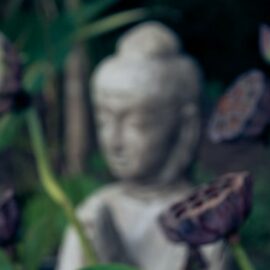

This article is an excerpt from the Shortform book guide to "Radical Acceptance" by Tara Brach. Shortform has the world's best summaries and analyses of books you should be reading.
Like this article? Sign up for a free trial here .
What is the story of Buddha under the Bodhi Tree? How can taking the time to pause give you a temporary nirvana?
After several years of searching for the answer to happiness, Siddhartha Gautama took a moment to pause under a tree. At this moment, he came to realize that there was room in the world for both suffering and beauty to coexist.
Continue on for the full story of Buddha and the Bodhi Tree.
How the Buddha Found the Pause
This is the traditional story of Buddha under the Bodhi Tree and the importance of pausing.
Siddhartha Gautama was the son of a king. The king’s advisors said that he would either become a holy man or a great king in his own right. Siddhartha’s father was determined that his son should be a king like he was, so he hid all the pain and suffering of the world from Siddhartha. However, when he was nearly 30, Siddhartha saw signs of age, disease, and death. He wondered how people could find happiness in such a harsh world, and set out to find the answer.
At first he looked for wisdom among the ascetics, people who starve and torture their bodies in the attempt to move beyond physical needs. After several years with them Siddhartha was gaunt and sick, but no closer to enlightenment. He left the ascetics to seek another way.
As he lay beside a river, sick and delirious, he remembered a very old memory. He’d been a child watching farmers at work, and he suddenly became aware of both the suffering and the beauty in the world.
The farmers sweated and groaned, the oxen strained to pull their plows, and countless insects were crushed and killed by the tilling. However, at the same time, the sky was beautifully blue, and filled with birds who flew through it effortlessly, joyfully. The air was rich and full of the scent of apple blossoms. Recognizing that there was room in the world for both suffering and joy, Siddhartha felt at peace.
The Bodhi Tree
As he came back to himself by the river, Siddhartha realized that he’d experienced that moment when he’d taken a moment to simply sit and watch, rather than chasing after pleasure or pushing away pain. He thought, then, that such a state of awareness and peace must be possible through calm contemplation.
After bathing, eating, and resting, Siddhartha found solitude under a pipal tree—now called the bodhi tree—and began to meditate. In his meditations, he confronted the embodiment of the human shadow, in the form of the god Mara (the Sanskrit word for delusion).
Mara tried to sway him with seduction, threats, and promises. However, Siddhartha met each challenge with Radical Acceptance; he neither pursued nor pushed away what Mara offered. Because Siddhartha refused to be ruled by the delusions, they had no power to harm him. Finally, the earth itself bore witness to Siddhartha’s right to be the Buddha, and Mara fled.
Siddhartha Gautama was a man who took the time to pause and confront his shadow. In doing so, he reached enlightenment and became the Buddha.
Practice Pausing
Learning Radical Acceptance means pausing over and over again. It means holding our tongue instead of lashing out in anger, or sitting with our anxiety instead of racing to find a distraction. Rather than trying to think or do, we simply experience what’s happening to us physically, mentally, and emotionally.
Pausing might seem awkward or unfamiliar, but there are already many moments where we take the time to do so. In the shower, perhaps, or while driving to work, we often find that we’re not worried about anything in particular—our minds are free to wander. A pause might be the sigh of relief when you figure out a difficult problem, or the moment when you lie down in bed and let go of the day’s stress.
The philosopher Ajahn Buddhadasa calls these short pauses “temporary nirvana.” We briefly experience true peace and freedom when we stop chasing or resisting experiences. He writes that those pauses are necessary; without them we’d either die or go mad.
The famous pianist Arthur Rubenstein was quoted as saying that he didn’t handle the notes better than anyone else—his art lived in the pauses. Like in music, the silence of a pause creates a background that brings the foreground into sharp relief. It makes what comes after it more deliberate and more meaningful.
In short, the pause is the moment when we can see all of the branching paths forward, like Buddha under the Bodhi Tree. For example, if someone has insulted us, in that pause we can see the various ways we could respond. What would the result be if we fought back; would the person back down, or would it simply escalate? What if we simply let it go; would things go back to normal, or would the person take it as permission to continue? There may not be a single correct answer, but in the pause we can see our options and try to choose wisely.

———End of Preview———
Like what you just read? Read the rest of the world's best book summary and analysis of Tara Brach's "Radical Acceptance" at Shortform .
Here's what you'll find in our full Radical Acceptance summary :
- How to live your life fully experiencing everything
- Why you need to let go of judging yourself or your experiences
- How you can acknowledge and welcome any experience






